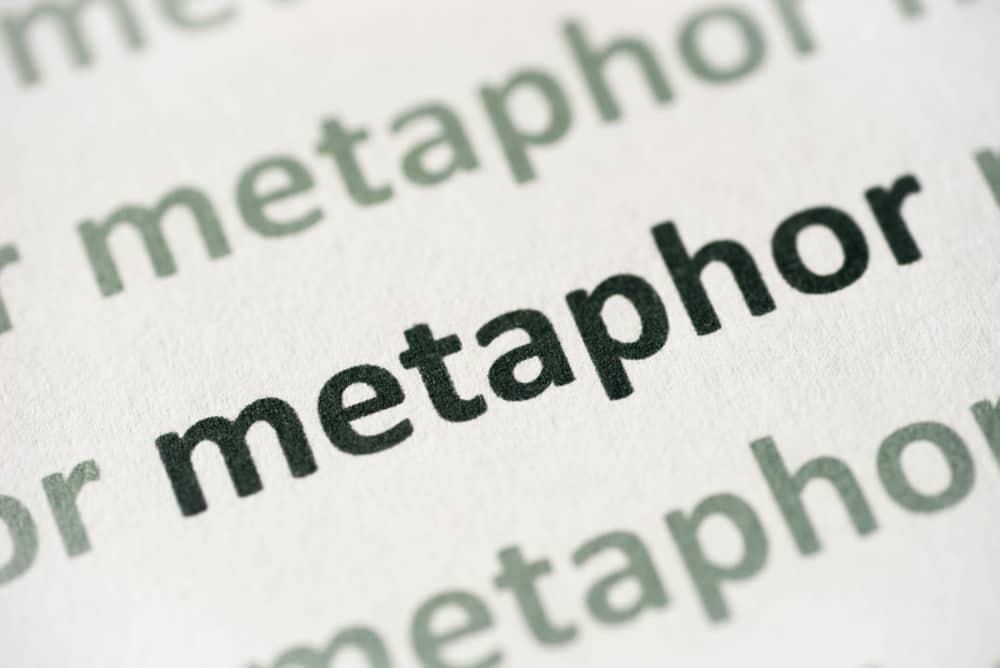
Metaphors are figures of speech often used to connect two unlike things or to denote something from a figurative standpoint. They enhance the quality of your writing regardless if it’s fiction, non-fiction, poetry, or a blog. Metaphors are powerful tools for explaining concepts that might otherwise be difficult for readers to grasp.
They also add color and spice to literature and provide a sneak peak to your psyche. Nowadays, they’re also used as a psychological technique.
Types
Related: Types of Speech | Types of Adjectives | Types of Adverbs | Types of Diction | Types of Nouns
Absolute Metaphor

This is a metaphor whereby one of the terms (the tenor) is indistinguishable from the other term (the vehicle). In other words, there is no connection between the main subject and the metaphor itself. When you’re looking at a non-absolute metaphor, you’ll notice that the basic ideas expressed and the metaphor itself resemble one another, at least slightly.
An example would include using the word “tube” to describe a train and the word “box” to indicate a house. On the other hand, an absolute metaphor can actually confuse people, which means that they will then think hard about its meaning. This is a natural reaction that results in learning something in the end.
Also called an anti-metaphor or a paralogical metaphor, the absolute metaphor is good to use when you can’t think of what to say. Therefore, absolute metaphors are a good way to let people know that you are uncertain or confused about a certain topic. In fact, many writers use absolute metaphors in an attempt to confuse their readers because this is what this metaphor does best.
Examples of absolute metaphors include:
- I am the dog end of every day.
- That is worth less than a dead horse.
- We faced a plethora of tasks.
- She is doing a tightrope walk with her studies this year.
- Death is a journey.
Complex (Compound) Metaphor

This is a metaphor in which the literal meaning is associated with two or more figurative terms, in other words, a combination of primary metaphors. Complex metaphors identify with another entity by essentially merging with a simple metaphor, whereby part of the metaphor is used to clear up a certain point.
Similar to a telescoped metaphor, a compound metaphor is a bit complex, and the vehicle actually becomes the tenor for the next metaphor, which becomes the tenor for the next one, and so on. In other words, a complex metaphor is a simple metaphor that is dependent on a secondary metaphoric element.
Using the word “light” for understanding is a good example of a complex metaphor, as you can “shine a light” on a certain situation. You can also freeze like a statue or watch a basketball as it gleefully dances into the basket.
Examples of complex metaphors include:
- She danced a crazy and colorful fairy.
- Ferocious, blind fog came down before his eyes.
- The car squealed in fiery anguish, its flesh laid bare in the unruly collision.
- Anger is a hot lava in a container.
- A planned-out life is a journey.
- It provides weight to the argument.
- They stood alone, stiff statues on the horizon.
- The golf ball happily danced into the hole.
Conceptual Metaphor

A conceptual metaphor includes one idea, the conceptual domain, that is understood in terms of another idea. It is a figurative comparison consisting of a conceptual domain which is understood when in relation of another. Examples include:
- That broken air conditioner cost me four hours.
- I invested two weeks in him.
- She is existing on borrowed time.
- You are a waste of time.
- This tool will save you hours.
- I don’t have the time to give you.
- How do you spend your time these days?
- You’re running out of time.
- Is that worth your valuable time?
Conceptual metaphors can also be broken down into three overlapping types:
- Ontological metaphor: when something concrete is projected onto something which is abstract in nature. An example is, my cell phone died on me.
- Orientational metaphor: these involve spatial relationships that can be demonstrated with words such as up and down, front and back, and on and off. An example includes, the situation is under my control.
- Structural metaphor: this involves one often-abstract and complex statement that is presented via a more concrete statement. An example is, time is a resource.
There are two parts to a conceptual metaphor, or two roles that the conceptual domains are involved in:
- The source domain: a domain that allows us to draw a metaphorical expression from it.
- The target domain: this can represent any part of the human experience; it represents something we attempt to understand.
Conceptual metaphors are frequently used by scientists and psychologists, and they can be experienced in everyday life. In fact, everyday language is filled with conceptual metaphors that we may not even notice because they are so common. If you say, she won the last argument, this is an example of a conceptual metaphor. You can understand conceptual metaphors through models and theories, because they link one idea to a better understanding somewhere else.
Conventional (Cognitive) Metaphor

Conventional metaphors include familiar comparisons that do not attract attention as a figure of speech. A conventional metaphor is heard or read in everyday language in a certain culture, and it lends some credibility to that specific culture’s understanding of the statement.
Examples of conventional metaphors include:
- Time is running out.
- It is time to move forward with your life.
- Time flies.
- You’re wasting my time.
- I have to finish this article and it is a race against time.
- Spend your time in a smart fashion.
Creative Metaphor

This is an original comparison, a figure of speech that calls attention to itself. It can be contrasted with dead metaphors or conventional metaphors, and it can also be called a novel metaphor, a literary metaphor, a poetic metaphor, or an unconventional metaphor.
Examples of creative metaphors include:
- It was as quiet as a church mouse.
- She was so quiet you could hear a pin drop.
- I can feel the quietness in the air.
- The silence was a screeching sound of anguish, intent on fracturing my soul.
- The silence deafened me.
- It was so quiet that she could hear her pulse beating out loud.
- The entire house screamed with silence.
Dead Metaphor

This is a figure of speech that loses its oomph and effectiveness because of frequent use. It has simply lost its force because it has been used so often. Dead metaphors are also called frozen metaphors or historical metaphors.
When a dead metaphor is used, the audience doesn’t necessarily notice that it is a metaphor, and they don’t need to visualize the action described in the metaphor because it is a very simple concept to understand. In fact, dead metaphors are often confused with clichés, and if you use a physical action or activity to demonstrate what you’re talking or writing about, this is the perfect example of a dead metaphor.
Dead metaphors are lost in time because they are no longer effective, and, in fact, they often are not even understood any longer. They no longer function as metaphors but instead are merely words, words that have a basic meaning. Part of this is the result of the “dumbing down” of language, not to mention the way certain meanings to certain words change over time.
Examples of dead metaphors include:
- You light up my life.
- Don’t get out of that contract or we will sue you.
- I need a new printer for my computer.
- New Orleans is as hot as an oven.
- I wrote the body of the essay.
- I looked at the hands on the clock.
Extended Metaphor

Extended metaphors compare two things that aren’t alike, but which continues throughout numerous sentences in a paragraph. It usually includes more than one sentence and occasionally fills up an entire paragraph. In extended metaphors, there is one main subject and several secondary subjects, which are used for comparing the two subjects.
An extended metaphor can act as the focal point of the statement, and it often shows how much commitment and passion the author has put into it. If an extended metaphor is done the right way, it can drive home the point with little effort. However, if it isn’t done the right way, it can actually confuse the readers or listeners, or even annoy them.
An extended metaphor is often called a “conceit,” and it is thought by some that this is because the writer is showing a certain amount of arrogance in redefining certain terms and making them hard to understand by the audience.
Examples of this type of metaphor include:
- Strolling along with ease.
- My life is like the Mississippi River.
- You have struggles in your life.
- We are trying to calm the storm.
- He is longing for some type of release.
- I like the gentle ocean.
Implied (Implicit) Metaphor

This is the comparison of two things with an implied similarity and not with direct words. In other words, the main point of the text is implied and not stated outright; it is also assumed to be understandable by the reader or listener. Often described as an incomplete description, the implied metaphor is written this way because the subject matter is already well-known, and, therefore, it doesn’t need to be explained in great detail. If you say that someone is “barking commands,” you are implying that person is like a dog. Examples of implied metaphors include:
- Spending too much time with her is worse than swimming in a lake of alligators.
- Don’t tuck your tail and run away.
- She purred over her latest birthday gift.
- Joanie squawked when the teacher gave the assignment.
- Please go and fetch us some lunch.
- He was chomping at the bit to hear this news.
Mixed Metaphor

A mixed metaphor is a succession of comparisons which are either ridiculous or incongruous. It is a collection of metaphors that may or may not mix well with one another.
People often use mixed metaphors on purpose, and they may even add a funny point to the metaphors. Mixed metaphors jump from one idea to another, the latter being inconsistent with the first one. Described as mis-matching metaphors, they can seem to make no sense on the surface, and if they do have something in common, it is often either inappropriate or tenuous at best.
Mixed metaphors can result when a writer tries to be overly elaborate or even careless, and the result can actually be humorous. Of course, you can deliberately use humor for a certain effect when you choose to use a mixed metaphor.
Examples of mixed metaphors include:
- In the heat of the moment, she turned to stone and swayed to the beat of her own drum.
- There will be a lot of new blood wreaking havoc in Washington.
- The ball is in your court and you should see the light at the end of the tunnel.
- I saw the writing on the wall, and it is like comparing oranges to apples.
- They got tired of the public’s outrage and published everything, warts and all.
Pataphors

These are extreme metaphors that go to extremes to express a certain statement or idea. They often do this by using extensions of a simple metaphor. In a pataphor, the principle is taken to its very limit, and it can be used as a way to further interest the audience and to make it a little more unique. Of course, you have to have the right balance of uniqueness and interest, because if the two overlap too much, the metaphor can be too vague and even unclear. Examples of pataphors include the following:
- John got one step closer to Margaret and made a date for Saturday night, checkmating.
- Mike was incredulous at losing to Shari so quickly stopped looking through rose-colored glasses, trodding downstairs furiously.
- They were destined to be so close, yet so far and separated by six degrees of separation.
Primary Metaphor

A primary metaphor is a basic and mostly understood metaphor which can be combined with other primary metaphors, which creates a complex metaphor. An example is “knowing is seeing” or “time is motion.” Primary metaphors combine something abstract and subjective with something more concrete. Other primary metaphors include:
- Life is theater.
- Bad is smelly.
- Time is motion.
- States are locations.
- Categories are containers.
- Important is big.
- Understanding is grasping.
- Seeing is touching.
- Control is up.
Root Metaphor

A root metaphor is a fact or narrative that directly affects a person’s view of the world and his or her interpretation of reality. Root metaphors are hidden and are a little on the tricky side. They do not seem to be metaphors on the surface, and they sometimes make it easier to produce other metaphors.
Essentially, root metaphors demonstrate how well someone understands the situation and is familiar with it. Root metaphors are very well-known among a culture or language, so much so that they are often not recognized as being metaphors. Root metaphors essentially produce other metaphors, and, because they are well-known among various cultures, they can mean something different from one culture to the next.
Root metaphors are also called basic metaphors, master metaphors, or myths. Examples of root metaphors include:
- Life is a journey.
- Nature as machine.
- Nature as kin.
- Nature as persons.
- Nature as creativity.
Submerged Metaphor

In a submerged metaphor one of the terms, the tenor or the vehicle, is not explicitly stated, but instead, it is implied. Submerged metaphors are very expressive and elaborate. Many people imagine things that are told to be a lot larger than they really are, and, as such, a submerged metaphor demonstrates the two ideas or statement in a big way.
Indeed, one part of the metaphor can be a symbol of the entire metaphor because when people are told about a small part of something, they often think of the whole piece of it automatically. This is partly due to the fact that memories work mostly by association. Hence, the first step is already done because the audience will automatically think of the whole part; in writing the metaphor, you provide the link from the metaphor to the subject. Some submerged metaphors include the following:
- Time flies.
- Her hair was a rat’s nest.
- She legged it.
- His thoughts were on the wing.
- A photon struck her.
- Bolts are for the most educated.
Therapeutic Metaphor

These metaphors are used by therapists to help a client during his or her personal transformation process. Therefore, it is a specialized type of metaphor, and it often involves a story or a way to parallel one situation to another. The purpose of a therapeutic metaphor is to relate one thing to another to make things a little clearer to the patient and to enable that patient to gain some insight into what they need to do in order to get a new outlook on a particular situation. Therapeutic metaphors include the following examples:
- Using a rubber band to make a point. (Don’t stretch yourself too thin.)
- Using a Hershey kiss candy. (Spread your love.)
- Using an eraser. (Erase your mistakes and start over.)
- Using a magnifying glass. (Don’t magnify these issues.)
- Using a crayon or marker. (Don’t see things in black and white.)
Visual Metaphor

In a visual metaphor, a person, place, or thing is represented through a visual image that suggests a similar point or an association of some type. In some ways, visual metaphors are easier to understand because people can view pictures of two or more objects and put them together.
Many people learn better when presented with visual tools, and a visual metaphor’s pictures help people connect the dots, so to speak, and learn something a lot more quickly than they would if the information had been given to them verbally or in written form.
Visual metaphors include pictures, drawings, and even full-colored photographs, and you can easily find some of them if you look online. They can be funny or serious, but their visual characteristic is what makes them so effective.
The Purpose of Using Metaphors

To Create a Specific Image
Metaphors can create a strong image in someone’s mind, not to mention leave an impression that will last. Saying “he was drowning in a sea of grief” creates a much stronger image than simply saying “he was sad.” The latter is somewhat bland and almost non-descriptive, whereas the first description results in a certain image that can create a lasting impression in someone’s mind and gut.
They are Especially Effective When They’re in Written Form
Metaphors can compare something literal with something that is intangible, and when they’re in written form, they are more forceful than making a statement verbally. Metaphors are exaggerations, but when they’re on the written page, they can paint a very vivid image in the reader’s mind. Words are powerful, and nowhere is this truer than when you’re reading a metaphor in a book or magazine.
They Can Help Children Learn to Enjoy the Art of Writing
Metaphors are colorful and interesting, and once you introduce children to them, they can get a real yen for learning how to write. If children are interested in writing poetry, metaphors can be especially effective, because metaphors paint pictures in the reader’s mind, usually very vivid pictures, making them especially useful in this type of writing.
What is the Difference Between a Metaphor and a Simile?

The Main Differences
- A simile is a type of metaphor; however, not all metaphors are similes.
- The word “metaphor” is a very broad term that can be thought of as the rhetorical transfer of one word’s aspects to another word.
- A simile is usually written by using the word “like” or “as,” or something which means “like” to make the comparison.
- Although metaphors can be mixed, this is not usually a good idea because it can confuse the audience.
- There are dozens of types of metaphors, and a simile is only one of them.
- A simile states the comparison conclusively; a metaphor does not.
- Both similes and metaphors attempt to compare two different subjects; however, a metaphor relates two things which are different, while a simile relates two things by making a correlation between the two things.
- A simile is a direct comparison, while a metaphor makes indirect comparisons.

Jon Dykstra is a six figure niche site creator with 10+ years of experience. His willingness to openly share his wins and losses in the email newsletter he publishes has made him a go-to source of guidance and motivation for many. His popular “Niche site profits” course has helped thousands follow his footsteps in creating simple niche sites that earn big.





